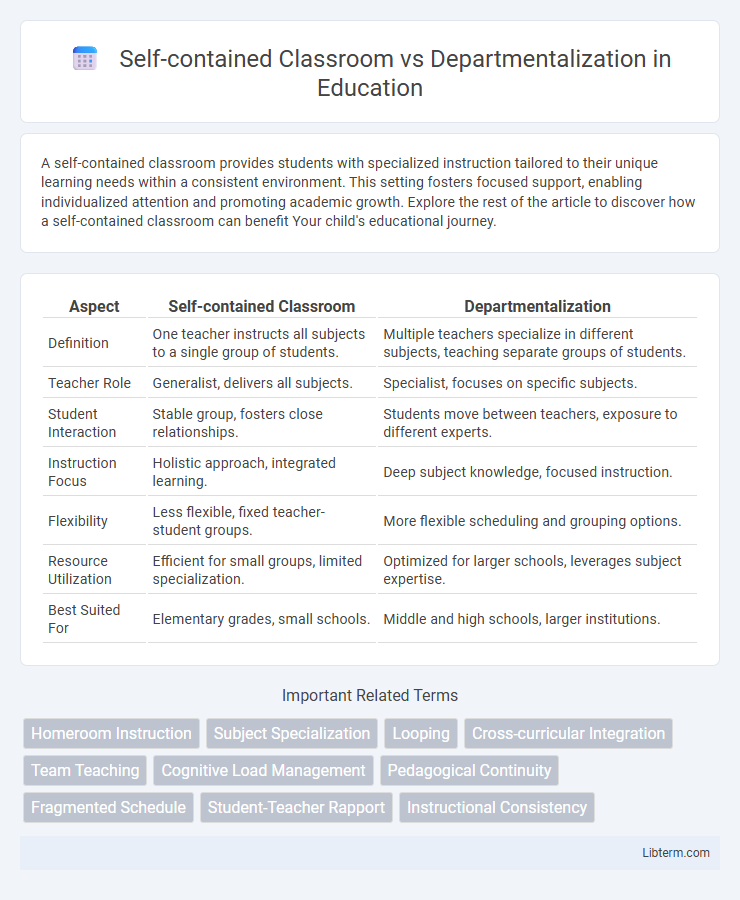A self-contained classroom provides students with specialized instruction tailored to their unique learning needs within a consistent environment. This setting fosters focused support, enabling individualized attention and promoting academic growth. Explore the rest of the article to discover how a self-contained classroom can benefit Your child's educational journey.
Table of Comparison
| Aspect | Self-contained Classroom | Departmentalization |
|---|---|---|
| Definition | One teacher instructs all subjects to a single group of students. | Multiple teachers specialize in different subjects, teaching separate groups of students. |
| Teacher Role | Generalist, delivers all subjects. | Specialist, focuses on specific subjects. |
| Student Interaction | Stable group, fosters close relationships. | Students move between teachers, exposure to different experts. |
| Instruction Focus | Holistic approach, integrated learning. | Deep subject knowledge, focused instruction. |
| Flexibility | Less flexible, fixed teacher-student groups. | More flexible scheduling and grouping options. |
| Resource Utilization | Efficient for small groups, limited specialization. | Optimized for larger schools, leverages subject expertise. |
| Best Suited For | Elementary grades, small schools. | Middle and high schools, larger institutions. |
Understanding Self-contained Classrooms
Self-contained classrooms group students with diverse needs in a single teacher's room, providing consistent instruction and fostering strong teacher-student relationships critical for individualized learning. This arrangement enhances classroom management and allows for tailored curriculum adjustments that accommodate various skill levels within one setting. Understanding self-contained classrooms is essential for recognizing their role in supporting students who require focused attention and continuity throughout the day.
What is Departmentalization in Education?
Departmentalization in education refers to the organizational structure where students are grouped by subject areas, and specialized teachers deliver instruction in their expert fields, such as math, science, or language arts. This approach allows for in-depth focus on specific disciplines, promoting subject mastery and efficient resource use. Departmentalization contrasts with self-contained classrooms, where a single teacher handles multiple subjects for the same group of students throughout the day.
Key Differences Between Self-contained and Departmentalization
Self-contained classrooms feature one teacher responsible for teaching all subjects to a single group of students, fostering stronger teacher-student relationships and consistent classroom management. Departmentalization divides subjects among specialized teachers who each focus on a specific content area, enhancing subject expertise and instructional depth. The key difference lies in instructional structure: self-contained classrooms emphasize holistic, continuous student support, while departmentalization promotes specialization and efficiency through segmented teaching.
Academic Benefits of Self-contained Classrooms
Self-contained classrooms foster individualized instruction by allowing teachers to tailor lessons to students' unique academic needs, promoting deeper understanding and consistent progress. This model enhances student-teacher relationships, leading to increased engagement and motivation, which are critical for academic success. Concentrated subject management within a single teacher's purview helps maintain continuity, reducing learning gaps and supporting steady cognitive development.
Academic Benefits of Departmentalization
Departmentalization enhances academic performance by allowing teachers to specialize in specific subjects, leading to deeper knowledge and more effective instruction. This approach fosters targeted curriculum development and assessment tailored to each discipline, improving student understanding and engagement. Collaborative opportunities among subject specialists further enrich the learning environment and promote academic excellence.
Social and Emotional Impacts on Students
Self-contained classrooms foster stronger teacher-student relationships, promoting emotional security and consistent social interactions that support students' emotional regulation and confidence. In contrast, departmentalization can offer diverse peer interactions and specialized instruction, which may enhance social skills but also increase anxiety due to frequent transitions and less teacher continuity. Balancing stability with opportunities for social growth is crucial for optimizing students' emotional well-being and academic engagement.
Teacher Expertise and Specialization
Self-contained classrooms typically feature one teacher responsible for delivering instruction across multiple subjects, fostering strong student-teacher relationships but limiting subject-specific expertise. Departmentalization employs specialized teachers for different subjects, enhancing instructional quality through teacher expertise in content areas such as math, science, or language arts. This model supports deeper specialization and often improves student outcomes in complex or advanced topics.
Flexibility and Classroom Management
Self-contained classrooms offer greater flexibility in tailoring lesson plans and pacing to meet diverse student needs, allowing teachers to manage classroom dynamics more effectively by maintaining consistent routines and relationships. Departmentalization, while promoting subject specialization and depth, may limit flexibility as students transition between teachers, potentially complicating behavior management and requiring more coordinated communication among staff. Effective classroom management in self-contained settings benefits from sustained teacher-student interactions, whereas departmentalized classrooms rely on structured schedules and collaborative strategies to maintain order and instructional continuity.
Suitability by Grade Level
Self-contained classrooms are highly suitable for early elementary grades, such as kindergarten through second grade, where students benefit from consistent routines and close teacher-student interaction. Departmentalization becomes more effective in middle and high school settings, typically from grades 6 to 12, as it allows subject specialization and prepares students for complex, varied curricula. Hybrid models may be adopted in upper elementary grades to balance teacher expertise with developmental needs.
Choosing the Right Approach for Your School
Choosing the right approach between self-contained classrooms and departmentalization depends on factors such as student age, subject complexity, and teacher expertise. Self-contained classrooms foster stronger teacher-student relationships by having one teacher manage all subjects, ideal for younger students. Departmentalization suits middle and high schools by allowing subject specialists to provide in-depth knowledge, enhancing academic rigor and student engagement.
Self-contained Classroom Infographic

 libterm.com
libterm.com